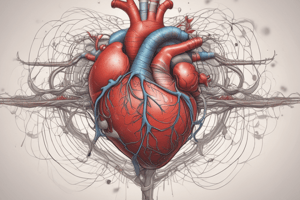Podcast
Questions and Answers
What is anatomy?
What is anatomy?
The study of the structure and shape of the body and its parts and their relationships to one another.
What is physiology?
What is physiology?
The study of how the body and its parts work or function.
Which of the following is the building block of matter?
Which of the following is the building block of matter?
- Cell
- Tissue
- Organ
- Atom (correct)
What is the main function of the heart?
What is the main function of the heart?
What is the function of white blood cells?
What is the function of white blood cells?
The _____ system is responsible for transporting blood.
The _____ system is responsible for transporting blood.
Which organ is considered a digestive organ due to bile production?
Which organ is considered a digestive organ due to bile production?
The pancreas has only endocrine functions.
The pancreas has only endocrine functions.
Which system is responsible for removing carbon dioxide from the body?
Which system is responsible for removing carbon dioxide from the body?
Match the organ systems with their functions:
Match the organ systems with their functions:
What is one of the necessary life functions?
What is one of the necessary life functions?
Flashcards are hidden until you start studying
Study Notes
Anatomy and Physiology
- Anatomy studies the structure, shape, and relationships of body parts.
- Physiology examines how the body and its components function.
Levels of Organization
- Atoms are the fundamental building blocks of matter.
- Cells are the smallest units of living organisms.
- Tissues consist of similar cells working together for a common function.
- Organs are formed from two or more tissue types working together.
- Organ systems are groups of organs that collaborate to achieve a specific purpose.
- Organisms represent the highest level of structural organization.
Key Body Systems
- Lymphatic System
- Transports fluid leaked from blood vessels back to the bloodstream.
- Lymph nodes and organs cleanse the blood and house white blood cells for immunity.
- Respiratory System
- Supplies oxygen to the body and removes carbon dioxide.
- Digestive System
- Breaks down food and provides nutrients to the bloodstream.
- Eliminates indigestible substances as feces.
- The liver aids in digestion by producing bile; the pancreas contributes enzymes.
- Urinary System
- Eliminates nitrogenous wastes and regulates water, electrolyte, and acid-base balance.
- Reproductive System
- Responsible for producing offspring.
- Testes generate sperm and male hormones; ovaries produce eggs and female hormones.
- Skeletal System
- Composed of bones, cartilage, and joints; provides structural support and mineral storage.
- Muscular System
- Facilitates body movement through muscle contraction.
- Nervous System
- Fast-acting control system that responds to stimuli via the brain, spinal cord, and nerves.
- Endocrine System
- Composed of glands that secrete hormones to regulate growth, reproduction, and metabolism.
- Cardiovascular System
- Transports blood and is essential for oxygen and nutrient delivery throughout the body.
Maintaining Life
- Necessary life functions include:
- Maintaining boundaries between internal and external environments.
- Movement of the body and substances within.
- Responsiveness to stimuli.
- Digestion and nutrient absorption.
- Metabolism for energy production.
- Excretion of waste products.
- Reproduction for species continuation.
- Growth for organism development and maintenance.
Studying That Suits You
Use AI to generate personalized quizzes and flashcards to suit your learning preferences.




